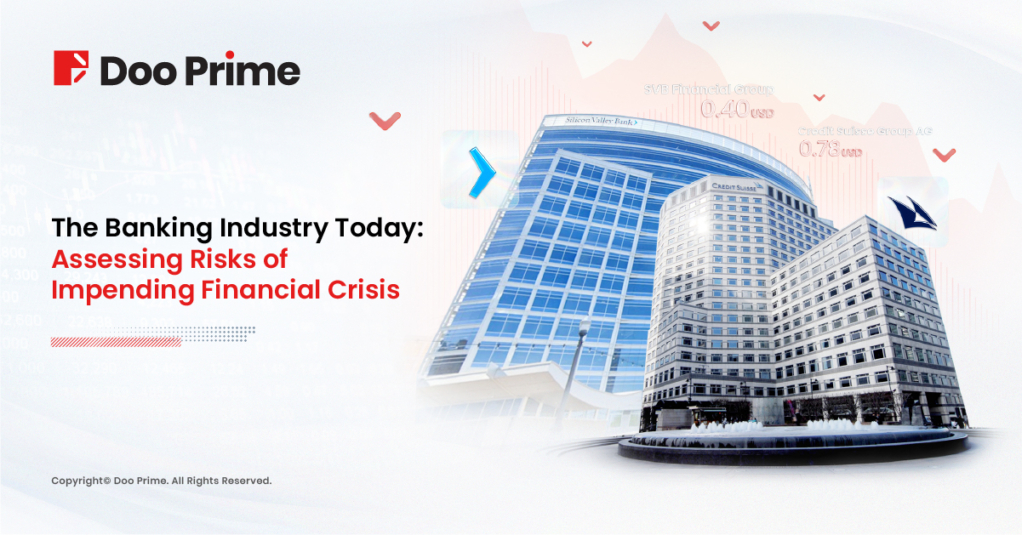
On 10th March 2023, Silicon Valley Bank (SVB), which was once the nation’s 16th-largest bank, suddenly announced its collapse after a run on depositors. A few days later, Credit Suisse, a leading investment bank with over 100 years of history, postponed its 2022 annual earnings report, subsequently sparking panic about its financial data and causing its share price to plummet. In the end, UBS acquired Credit Suisse for 3 billion Swiss francs, brokered by the Swiss government.
The banking industry has been in flux lately, with major banks frequently exposed to liquidity crises, resulting in falling industry share prices. This is reminiscent of the financial crisis that struck the world 15 years ago. Could SVB and Credit Suisse become the triggers for a new round of financial crisis like Bear Stearns and Lehman in 2008?
In this article, we will examine the situation to determine if a financial crisis is looming once again.

From Crisis to Recovery: A Historical Account of the 2008 Financial Meltdown
When a crisis begins, it is unusual for many people to recognize that a seemingly insignificant event can trigger a tidal wave of consequences.
In the case of the 2008 financial crisis, the first event was the near bankruptcy of Bear Stearns, the nation’s fifth largest investment bank, in 2007. This happened after it reported a 10% drop in quarterly earnings on 14th June 2007, due to the weak mortgage market’s impact.
Later, on 1st August 2007, Bear Stearns announced the collapse of two funds that invested in securitized subprime loans, resulting in investors losing more than USD 1.5 billion.
However, at the time, the capital markets did not appear to be significantly impacted, and Federal Reserve Chairman Ben Bernanke even stated that the subprime crisis would not severely harm the economy. This illustrates that the market regarded the troubles faced by Bear Stearns as a local crisis.
Although these events did not cause much damage at the time, they marked the beginning of a local crisis that soon turned into a widespread panic.
The subprime crisis arose from allowing low-income people who did not meet standard credit ratings to purchase property through subprime loans. Banks would then package these loans into financial products known as “real estate mortgage securities” or mortgage-backed securities (MBS) and sell them to other investment banks or investors. Naturally, rating agencies rated these MBS products as safe and good, assuming that the U.S. property market would continue to rise.
However, in July 2007, S&P and Moody’s downgraded the ratings of MBS products involving subprime mortgages, leading to a wave of panic and falling prices.
People began to realize that the safety of subprime products had been overestimated, and that Bear Stearns’ subprime problems might be widespread rather than simply a local crisis.
With this, more funds began to flee in search of peace of mind, causing investment banks to freeze relevant subprime funds and prohibiting investors from handling redemptions. However, this intensified the pace of redemptions, and in the following months, more and more investment banks faced bankruptcy.
In September 2008, the subprime mortgage crisis led to Lehman Brothers, the fourth largest investment bank in the U.S., filing for bankruptcy protection, which made people finally realize the severity of the crisis.
As major players in the financial market were tied together through MBS, credit default swaps (CDS), and other financial derivatives, no one could guarantee that they would be unaffected by the bankruptcy of any institution. This led to a chain reaction, with insurance companies AIG, Merrill Lynch, Freddie Mac, and Fannie Mae facing bankruptcy crises not long after.
Looking back at the 2008 financial crisis, we can identify several key characteristics that contributed to the crisis:
- At that time, the U.S. real estate market was booming, and there was a widespread belief that home prices would continue to rise indefinitely. This led to a false sense of prosperity and economic activity that was overheated.
- The Federal Reserve kept interest rates low for an extended period of time, which encouraged borrowing and speculation in the housing market. However, when they eventually raised interest rates, it created a shock to the system and triggered the crisis.
- Subprime loans were interconnected through multiple derivatives that linked the major players in the financial market, creating a ripple effect of financial risk. Eventually, the subprime mortgage market turned out to be a huge financial hole, with significant financial vulnerabilities.
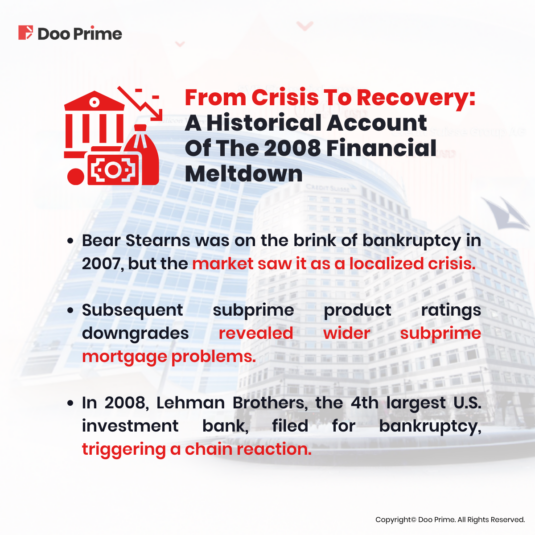
In the following sections, we will analyze whether there are connections between these characteristics and the current situation.
Financial Industry on Edge: Silicon Valley Bank and Credit Suisse Show Signs of Instability
After reviewing the 2008 financial crisis, we now have a better understanding of the background of the crisis, which helps us better understand current events. While the term “subprime crisis” was used to summarize the crisis 15 years ago, the current bank meltdown can be explained as a “liquidity crisis”.
Silicon Valley Bank, founded in 1983 and listed on the Nasdaq in 1988, provides banking services for Silicon Valley startups rather than serving ordinary depositors.
During the 2020 COVID-19 pandemic, the Federal Reserve responded with unprecedented lending intensity, resulting in a large influx of hot money into the capital market. Many venture capital institutions for technology startups obtained a large amount of funds in a short period of time, and a lot of these funds were logically deposited in Silicon Valley banks.
However, due to weak demand for loans, banks invested the deposit funds in safer, more secure liquid assets, mainly long-term U.S. debt and mortgage-backed securities (MBS).
It was this wave of buying U.S. debt and MBS that set the stage for the liquidity crisis of Silicon Valley banks later.
During the period of low interest rates in 2020-2021, there was a surge of purchases of U.S. debt and Mortgage-Backed Securities (MBS) that led to a liquidity crisis in Silicon Valley banks later on.
When the Federal Reserve abruptly cut interest rates during that period, it triggered a rapid decline in the prices of long-term U.S. bonds and MBS when interest rates were raised aggressively after 2022.
As a result, banks like Silicon Valley Bank, which had invested heavily in these assets during the low-rate period, experienced significant losses on their books.
However, when the Fed cut interest rates and then aggressively raised them, the value of these assets plummeted, causing Silicon Valley Bank to incur losses.
As the bank lost deposits due to the economic downturn and hot money flowed out, it gradually faced a liquidity crisis. To address this, the bank sold some of its long-term U.S. debt assets and planned to issue new shares to raise capital. However, this move led to a large number of depositors running on the bank, causing it to declare bankruptcy.
Just a few days after the collapse of Silicon Valley Bank, internationally renowned investment bank Credit Suisse declared that there were “significant deficiencies” in its financial reports for the past two years, almost tantamount to declaring that it had committed financial fraud.
Credit Suisse also said it would postpone its 2022 annual report, and its largest shareholder, Saudi National Bank, refused to inject any more capital into Credit Suisse. It was subsequently acquired by UBS for a mere 3 billion Swiss francs.
While Silicon Valley’s crisis stemmed from a lack of liquidity, Credit Suisse’s crisis was more multifaceted. Not only had Credit Suisse been experiencing a decline in depositors’ trust in recent years, but also a series of negative incidents have damaged its reputation.
These incidents include poor returns on its own investment business, helping drug cartels in money laundering, compromising its neutral status by freezing deposits of Russian funds, and other actions. All of these have contributed to a negative impact on the 100-year-old Credit Suisse brand.
Furthermore, the high interest rate environment caused by the Federal Reserve and the European Central Bank has not been favorable for the development of banking businesses, further deteriorating Credit Suisse’s business prospects. Ultimately, these factors led to the consequences of the acquisition.
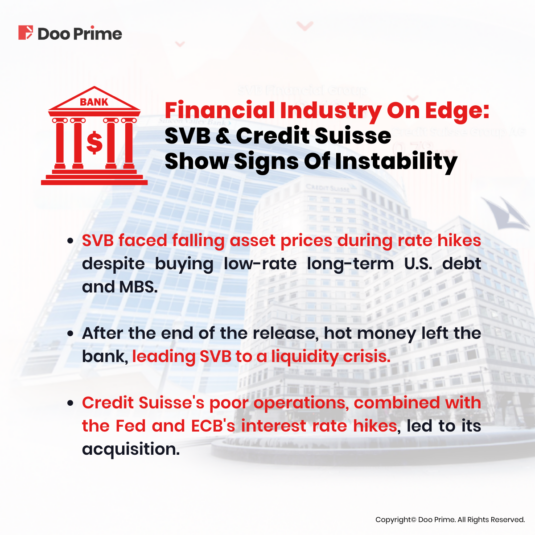
Is a Financial Crisis Looming?
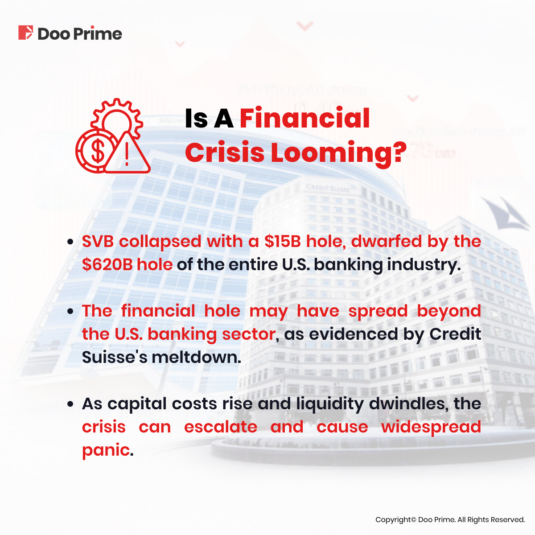
After Silicon Valley Bank’s collapse, the U.S. Treasury Department quickly committed to protecting bank depositors’ deposits. Similarly, the Swiss government took decisive action to prevent the collapse of Credit Suisse and triggered its acquisition of UBS.
The governments’ rapid responses seemed to have averted immediate danger, and many believe the banking crisis to be a local dilemma. However, underlying assets in the banking industry remain a potential risk for systemic crisis.
Silicon Valley Bank invested heavily in long-term U.S. debt and MBS markets during low-interest rate environments. It failed to cope with the liquidity crisis in today’s high-interest rate environment, suffering a financial loss of approximately USD 15 billion.
At the same time, other banks also suffered from poor risk management and liquidity crises. Martin Gruenberg, chairman of the FDIC, projects Silicon Valley Bank’s book loss from investing in U.S. debt to be about USD 620 billion for the entire U.S. banking industry by the end of 2022. The potential financial hole for the entire U.S. banking industry is 40 times larger than that of Silicon Valley alone.
If banks safely hold long-term assets until maturity, book losses won’t translate into actual losses. But today’s panic exacerbates the bank run crisis and further increases liquidity risk.
Moreover, Credit Suisse’s meltdown indicates that a similar banking crisis is a global problem, not just in the US. Credit Suisse’s low international investment banking position and non-publication of financial results for 22 years raise concern about the potential size of the hole hidden behind it.
To add, economic development does not cause or prevent financial crises. The key lies in the potential cause of the disease and whether it evolves into a serious one. History shows that a few tens of billions of dollars of financial holes are only the precursors of crises that slowly spread to other asset classes, industries, or regions, eventually triggering the collapse of larger giants, increasing people’s fear.
Assets that trigger a full-blown crisis are often underestimated or undervalued in the early stages of a crisis. The persistent fragility of financial system regulation causes this problem.
Although financial regulation is now more comprehensive and effective than 100 years ago, it is impossible to regulate everything. There is always a possibility that underestimated assets lead to crises due to panic mines.
Ultimately, the economy and financial markets follow a cycle of prosperity, rapid development, stagnation, and recession. Raising or lowering interest rates or expanding or reducing the meter cannot easily reverse this cycle.
The Fed’s unprecedented action during the pandemic followed by a reversal of the wind to tighten in 2022 poses a sudden change in direction that concentrates many hidden dangers planted during the pandemic during the interest rate hike.
This situation is similar to the 2008 crisis. The same Fed maintained a low-interest rate environment in the first few years and then raised interest rates, triggering the crisis.
Now, the Fed faces a dilemma during economic downturns. Reviving consumer and economic confidence require interest rate cuts, but this conflicts with the Fed’s goal of suppressing inflation. Thus, maintaining interest rate hikes exacerbates the current banking liquidity crisis, further increasing the possibility of a broader financial crisis.
At this point, the Fed is in a delicate state of tightrope walking. On 22nd March, the Fed raised interest rates by 25 basis points. However, during the second week of March, the U.S. banking sector used the discount window to borrow a record-high USD 152.85 billion from the Fed, releasing funds to the banking sector to prevent a liquidity crisis.
Although the risky maneuver of stepping on the gas and brakes at the same time can be avoided, a financial crisis may still occur. The 2008 subprime mortgage crisis was caused by tying together various derivatives and institutions in the financial market, resulting in a huge financial hole.
Today, a similar situation has arisen due to poor risk management in the banking sector, where many long-term bond assets were purchased in previous years when interest rates were low.
In today’s high-interest environment, these assets must be sold in advance to replenish liquidity, which has resulted in actual financial losses. As a result, the U.S. and Swiss governments are providing as much liquidity as possible to help banks through the immediate crisis.
While some believe that the long-term U.S. debt that banks invest in is a healthy and safe asset, it lacks liquidity and may trigger a loss of confidence in the financial system.
The essence behind a financial crisis is a lack of confidence, which can occur even with so-called safe assets in a particular environment. For instance, Credit Suisse’s Additional Tier 1 (AT1) bonds were ruthlessly written down to ease the liquidity crisis, causing investors to lose their investments. Although AT1 bonds are safer than subprime mortgages, the practice of writing them down will weaken confidence in the financial system.
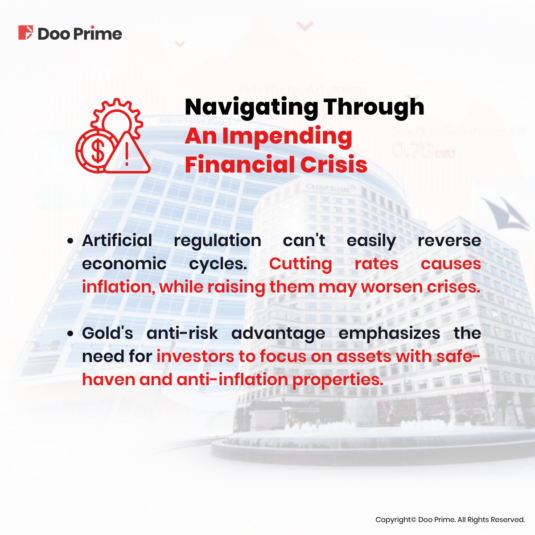
The current crisis presents a difficult choice for the Federal Reserve and the European Central Bank. Raising interest rates will increase the likelihood of a crisis, while cutting them will waste previous efforts to keep inflation down.
In this environment, investors may consider allocating a certain degree of gold and maintaining cash reserves. Gold prices will likely rise if a crisis occurs, and cutting interest rates will also benefit gold as a bulk asset.
Investors should focus on assets with safe-haven and anti-inflation properties to be prepared for any potential crisis, whether it be a sudden outbreak or a long-term decline.
| About Doo Prime
Our Trading Products
Securities | Futures | Forex | Precious Metals | Commodities | Stock Indices
Doo Prime is an international pre-eminent online broker under Doo Group, which strives to provide professional investors with global CFD trading products in Securities, Futures, Forex, Precious Metals, Commodities, and Stock Indices. At present, Doo Prime is delivering the finest trading experience to more than 90,000 clients, with an average trading volume of more than USD 51.223 billion each month.
Doo Prime entities respectively holds the relevant financial regulatory licenses in Seychelles, Mauritius, and Vanuatu with operation centers in Dallas, Sydney, Singapore, Hong Kong, Dubai, Kuala Lumpur, and other regions.
With robust financial technology infrastructure, well-established partnerships, and an experienced technical team, Doo Prime boasts a safe and secure trading environment, competitive trading costs, as well as deposit and withdrawal methods that support 20+ different currencies. Doo Prime also incorporates 24/7 multilingual customer service and extremely fast trade execution via multiple industry-leading trading terminals such as MT4, MT5, TradingView, and Doo Prime InTrade, covering over 10,000 trading products.
Doo Prime’s vision and mission are to become a financial technology-focused broker, streamlining international global financial products investment.
For more information about Doo Prime, please contact us at:
Phone:
Europe : +44 11 3733 5199
Asia : +852 3704 4241
Asia – Singapore: +65 6011 1415
Asia – China : +86 400 8427 539
E-mail:
Technical Support: en.support@dooprime.com
Account Manager: en.sales@dooprime.com
Forward-looking Statements
This article contains “forward-looking statements” and may be identified by the use of forward-looking terminology such as “anticipate”, “believe”, “continue”, “could”, “estimate”, “expect”, “hope”, “intend”, “may”, “might”, “plan”, “potential”, “predict”, “should”, or “will”, or other variations thereon or comparable terminology. However, the absence of such terminology does not mean that a statement is not forward-looking. In particular, statements about the expectations, beliefs, plans, objectives, assumptions, future events, or future performance of Doo Prime will be generally assumed as forward-looking statements.
Doo Prime has provided these forward-looking statements based on all current information available to Doo Prime and Doo Prime’s current expectations, assumptions, estimates, and projections. While Doo Prime believes these expectations, assumptions, estimations, and projections are reasonable, these forward-looking statements are only predictions and involve known and unknown risks and uncertainties, many of which are beyond Doo Prime’s control. Such risks and uncertainties may cause results, performance, or achievements materially different from those expressed or implied by the forward-looking statements.
Doo Prime does not provide any representation or warranty on the reliability, accuracy, or completeness of such statements. Doo Prime is not obliged to provide or release any updates or revisions to any forward-looking statements.
Risk Disclosure
Trading in financial instruments involves high risks due to the fluctuation in the value and prices of the underlying financial instruments. Due to the adverse and unpredictable market movements, large losses exceeding the investor’s initial investment could incur within a short period of time. The past performance of a financial instrument is not an indication of its future performance. Investments in certain services should be made on margin or leverage, where relatively small movements in trading prices may have a disproportionately large impact on the client’s investment and client should therefore be prepared to suffer significant losses when using such trading facilities.
Please make sure you read and fully understand the trading risks of the respective financial instrument before engaging in any transaction with Doo Prime’s trading platforms. You should seek independent professional advice if you do not understand any of the risks disclosed by us herein or any risk associated with the trade and investment of financial instruments. Please refer to Doo Prime’s Client Agreement and Risk Disclosure and Acknowledgement Notice to find out more.
Disclaimer
This information is addressed to the general public solely for information purposes and should not be taken as investment advice, recommendation, offer, or solicitation to buy or sell any financial instrument. The information displayed herein has been prepared without any reference or consideration to any particular recipient’s investment objectives or financial situation. Any references to the past performance of a financial instrument, index, or a packaged investment product shall not be taken as a reliable indicator of its future performance. Doo Prime and its holding company, affiliates, subsidiaries, associated companies, partners and their respective employees, make no representation or warranties to the information displayed and shall not be liable for any direct, indirect, special or consequential loss or damages incurred a result of any inaccuracies or incompleteness of the information provided, and any direct or indirect trading risks, profit, or loss arising from any individual’s or client’s investment.



